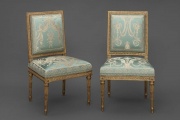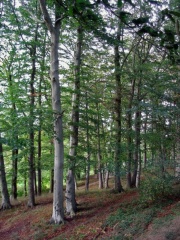Difference between revisions of "Beech"
(username removed) |
(username removed) |
||
| Line 2: | Line 2: | ||
== Description == | == Description == | ||
| − | Deciduous, smooth-bark trees of the genus ''Fagus'' native to temperate regions of the northern hemisphere. Commonly known varieties are the [http://cameo.mfa.org/materials/fullrecord.asp?name=European | + | Deciduous, smooth-bark trees of the genus ''Fagus'' native to temperate regions of the northern hemisphere. Commonly known varieties are the [http://cameo.mfa.org/materials/fullrecord.asp?name=European%20beech European beech] tree (''F. sylvatica'') and the [http://cameo.mfa.org/materials/fullrecord.asp?name=American%20beech American beech] (''F. grandifolia''). The pale reddish-brown, close-grain beechwood is hard and heavy. It bends well, is durable under water, and gives a smooth shiny finish. Beech is a commonly used timber for flooring, cabinetry, furniture (especially bentwood chairs), veneer, plywood, tool handles, and turnery. It was used in panel paintings in western Europe. Beech nuts provide forage for game animals and yield an edible oil. |
[[File:53.2850-SC40529.jpg|thumb|'''MFA Acc. #:''' 53.2850]] | [[File:53.2850-SC40529.jpg|thumb|'''MFA Acc. #:''' 53.2850]] | ||
== Synonyms and Related Terms == | == Synonyms and Related Terms == | ||
| − | beechwood; American beech (Fagus grandifolia); European beech (Fagus sylvatica); | + | beechwood; American beech (Fagus grandifolia); European beech (Fagus sylvatica); Bøg (Dan.); hêtre (Fr.); Buche (Deut.); faggio (It.); haya (Esp.); beuk (Ned.); bøk (Nor.); buk (Pol.); bok (Sven.); faia (Port.) |
== Other Properties == | == Other Properties == | ||
| Line 47: | Line 47: | ||
== Authority == | == Authority == | ||
| − | * | + | * R. J. Gettens, G.L. Stout, ''Painting Materials, A Short Encyclopaedia'', Dover Publications, New York, 1966 Comment: American beech = Fagus americana |
| − | * | + | * External source or communication Comment: Hardwood Manufacturers Institute, Memphis Tenn.: air-dry weight = 44 pcf |
* Wikipedia, the free encyclopedia, at http://www.wikipedia.com Comment: http://en.wikipedia.org/wiki/Beech (Accessed Oct. 8, 2005) | * Wikipedia, the free encyclopedia, at http://www.wikipedia.com Comment: http://en.wikipedia.org/wiki/Beech (Accessed Oct. 8, 2005) | ||
| − | * ''Encyclopedia Britannica'', http://www.britannica.com Comment: Beech. Retrieved May 24, 2003, from | + | * ''Encyclopedia Britannica'', http://www.britannica.com Comment: Beech. Retrieved May 24, 2003, from Encyclopædia Britannica Premium Service. |
| − | * | + | * G.S.Brady, ''Materials Handbook'', McGraw-Hill Book Co., New York, 1971 Comment: p.93 |
* ''Dictionary of Building Preservation'', Ward Bucher, ed., John Wiley & Sons, Inc., New York City, 1996 | * ''Dictionary of Building Preservation'', Ward Bucher, ed., John Wiley & Sons, Inc., New York City, 1996 | ||
| − | * | + | * Hermann Kuhn, ''Conservation and Restoration of Works of Art and Antiquities'', Butterworths, London, 1986 |
* ''Caring for your Collections'', Arthur W Schulz (ed.), Harry N. Abrams, Inc. , New York, 1992 | * ''Caring for your Collections'', Arthur W Schulz (ed.), Harry N. Abrams, Inc. , New York, 1992 | ||
| − | * | + | * F. H. Titmuss, ''Commercial Timbers of the World'', The Technical Press Ltd., London, 1965 Comment: weight = 45-55 ppcf |
| − | * | + | * Michael McCann, ''Artist Beware'', Watson-Guptill Publications, New York City, 1979 |
| − | * | + | * George Savage, ''Art and Antique Restorer's Handbook'', Rockliff Publishing Corp, London, 1954 |
| − | * | + | * Pam Hatchfield, ''Pollutants in the Museum Environment'', Archetype Press, London, 2002 Comment: highly acidic |
* ''CRC Handbook of Chemistry and Physics'', Robert Weast (ed.), CRC Press, Boca Raton, Florida, v. 61, 1980 Comment: density=43-56 ppcf (0.7-0.9 g/cm3) | * ''CRC Handbook of Chemistry and Physics'', Robert Weast (ed.), CRC Press, Boca Raton, Florida, v. 61, 1980 Comment: density=43-56 ppcf (0.7-0.9 g/cm3) | ||
Revision as of 07:24, 24 July 2013
Description
Deciduous, smooth-bark trees of the genus Fagus native to temperate regions of the northern hemisphere. Commonly known varieties are the European beech tree (F. sylvatica) and the American beech (F. grandifolia). The pale reddish-brown, close-grain beechwood is hard and heavy. It bends well, is durable under water, and gives a smooth shiny finish. Beech is a commonly used timber for flooring, cabinetry, furniture (especially bentwood chairs), veneer, plywood, tool handles, and turnery. It was used in panel paintings in western Europe. Beech nuts provide forage for game animals and yield an edible oil.
Synonyms and Related Terms
beechwood; American beech (Fagus grandifolia); European beech (Fagus sylvatica); Bøg (Dan.); hêtre (Fr.); Buche (Deut.); faggio (It.); haya (Esp.); beuk (Ned.); bøk (Nor.); buk (Pol.); bok (Sven.); faia (Port.)
Other Properties
Large trees growing to 35 m. Bark=smooth, gray. Leaves=simple with veins and toothed edges. Fruit=Large husk containing 2 shiny brown edible nuts.
Wood is acidic. Color: Pinkish brown with dark brown rays. Rings: obscure. Pores: diffuse, fine. Grain: faint. Rays: distinct. Hard, strong and heavy. Specific gravity = 0.7-0.9
| Density | 43-56 ppcf |
|---|
Hazards and Safety
Skin contact and dust inhalation may cause irritation and allergies.
May evolve volatile organic acids.
Additional Information
Schoch, W., Heller, I., Schweingruber, F.H., Kienast, F., 2004:Wood anatomy of central European Species: Beech,Fagus sylvatica L.
Additional Images
Authority
- R. J. Gettens, G.L. Stout, Painting Materials, A Short Encyclopaedia, Dover Publications, New York, 1966 Comment: American beech = Fagus americana
- External source or communication Comment: Hardwood Manufacturers Institute, Memphis Tenn.: air-dry weight = 44 pcf
- Wikipedia, the free encyclopedia, at http://www.wikipedia.com Comment: http://en.wikipedia.org/wiki/Beech (Accessed Oct. 8, 2005)
- Encyclopedia Britannica, http://www.britannica.com Comment: Beech. Retrieved May 24, 2003, from Encyclopædia Britannica Premium Service.
- G.S.Brady, Materials Handbook, McGraw-Hill Book Co., New York, 1971 Comment: p.93
- Dictionary of Building Preservation, Ward Bucher, ed., John Wiley & Sons, Inc., New York City, 1996
- Hermann Kuhn, Conservation and Restoration of Works of Art and Antiquities, Butterworths, London, 1986
- Caring for your Collections, Arthur W Schulz (ed.), Harry N. Abrams, Inc. , New York, 1992
- F. H. Titmuss, Commercial Timbers of the World, The Technical Press Ltd., London, 1965 Comment: weight = 45-55 ppcf
- Michael McCann, Artist Beware, Watson-Guptill Publications, New York City, 1979
- George Savage, Art and Antique Restorer's Handbook, Rockliff Publishing Corp, London, 1954
- Pam Hatchfield, Pollutants in the Museum Environment, Archetype Press, London, 2002 Comment: highly acidic
- CRC Handbook of Chemistry and Physics, Robert Weast (ed.), CRC Press, Boca Raton, Florida, v. 61, 1980 Comment: density=43-56 ppcf (0.7-0.9 g/cm3)






